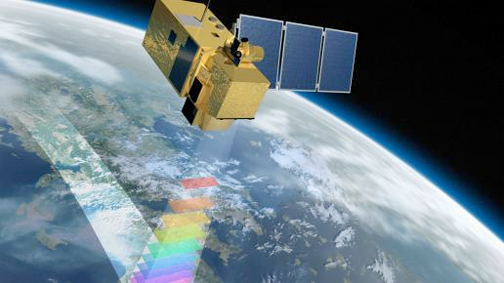“We want the instruments for the Sentinel-1 satellites to be another chapter in our space radar success story,” said Eckard Settelmeyer, Director in Germany of Earth Observation, Navigation and Science at Astrium. “As well as bearing overall industrial responsibility for the European ERS-1/ERS-2 and Envisat satellites, Astrium has also developed and built the AMI (ERS), ASAR (Envisat) and ASCAT (MetOp) radar payloads. On top of this, Astrium has overall responsibility for the German TerraSAR-X and TanDEM-X radar satellite projects, as well as the planned phased array satellites of the SARah program – all in all, a long and successful line of technologies and products.”

Sentinel-1, -2 and -3: The space component of the GMES program
© Astrium.
Sentinel-1 has been specially designed for a wide range of environmental tasks including surveillance of maritime environment and monitoring of sea ice and oil spills, landslides and floods. It will assist in reconnaissance and operational support activities in response to natural disasters, for which the latest data is required as rapidly as possible.
It will also be possible to use these data to determine longer-term environmental changes, such as changes to the size of ice sheets in Greenland and Antarctica.
From 2014 onwards, the satellite‚—which weighs about 2.3 tons— will orbit the Earth at an altitude of about 700km. On each orbit, it will fly over the North and South Poles, scanning “strips” of the Earth with the radar instrument as the Earth revolves beneath it. One new development is that the Astrium radar will make it possible to record data continuously (around the clock). Sentinel-1A, which will be launched on a Soyuz rocket from the European spaceport in Kourou, French Guiana, is set to observe the Earth from its orbit for at least seven years.
Sentinel-1B, a twin satellite, will be launched around 18 months after Sentinel-1A, with the aim of improving revisit intervals (ie. access to every point on Earth within the shortest time). It will then be possible to map the whole world in only six days (using both satellites).
The heart of the mission is the C-band SAR instrument built by Astrium whose basic technologies, like the T/R modules and the Front End Electronics for the antenna as well as the advanced data management and transmission subsystems has been built by Thales Alenia Space.
Its most noticeable characteristic is its active electronic antenna measuring 12.30 metres by 0.90 metres. In Synthetic Aperture Radar (SAR), the flight movement of the satellite simulates a virtual antenna much larger than the physical one on board the satellite. This considerably improves the resolution of the resulting images. The C-band radar beam, which has a wavelength of 6 cm, penetrates crops to reach the surface, and can determine changes in the Earth’s surface to millimetres.
The Sentinel-1 SAR instrument, which was built by Astrium in Friedrichshafen, is equipped with a waveguide antenna, which consists of 560 individual antennas coupled to each other. The connected SAR electronics were supplied by Astrium in Portsmouth, UK. The active antenna can be aimed electronically at an area to be scanned without having to be moved. With the help of this technology several neighbouring strips can be scanned at once, and subsequently combined to provide an overview.


